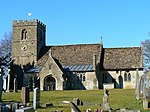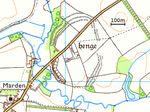Long Barrow at All Cannings

The Long Barrow at All Cannings is a modern barrow near All Cannings, Wiltshire, England, inspired by the neolithic barrows built 5,500 years ago. It was the first barrow built in Britain in thousands of years. The structure was commissioned by farmer and Stonehenge steward Timothy Daw, and completed in 2014. A sequence of stone chambers under an earthen mound contains 340 niches for the placement of cremation urns, which were sold for £1,000 each to pay for the construction of the barrow.BBC television programme Countryfile filmed at the barrow in 2016.In 2018 it was approved as a place of worship.The barrow has been associated with the revival of barrow building in the UK.
Excerpt from the Wikipedia article Long Barrow at All Cannings (License: CC BY-SA 3.0, Authors, Images).Long Barrow at All Cannings
Woodway Bridge,
Geographical coordinates (GPS) Address Nearby Places Show on map
Geographical coordinates (GPS)
| Latitude | Longitude |
|---|---|
| N 51.3637 ° | E -1.8961 ° |
Address
The Long Barrow at All Cannings
Woodway Bridge
SN10 3NX , All Cannings
England, United Kingdom
Open on Google Maps











